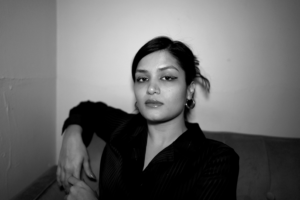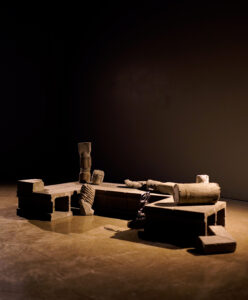The 2025 Russell and Paula Panczenko MFA Prize winner is Anamika Singh. A current MFA candidate at UW–Madison, Singh’s mixed media practice is the focus of Corpus: an exhibition by Anamika Singh, on view April 7-July 13, 2025
Through installation, sculpture, photography and film, Singh presents both familial narratives from her native India and shared histories that transcend geopolitical boundaries. Her solo exhibition examines the instrumentalization of archaeology in nationalism and control, highlighting the link between urban destruction and architectural construction. The works pose questions about loss amid development—change that Singh has witnessed in India and the United States.
Singh’s film, Sheetla, informs the exhibition. The film follows the Hindi language daily journal Jan Morcha and its role in reporting the highly contested desecration of the Babri Masjid in Ayodhya, Faizabad in 1992. Singh titled the film in honor of her grand uncle, Sheetla Singh, a prominent editor, journalist and union leader in north India. He served as the editor of Jan Morcha for fifty years.

Anamika Singh, photo by Agya Salas
“Being born and raised in the Indian subcontinent and the US deeply influenced my questions around power, violence and history. In both places, I witnessed the desire to capture and own history and to have authority over it. My work doesn’t think about history as a vestige of the past but very much as something that is reanimated over within the present and to mark the future. My work invites people to re-approach and reopen complex histories that are often relegated to the domain of experts to challenge the notion of singular histories that are petrified in time,” said Singh.
Corpus is the culmination of three years of research-based artistic practice in the United States and India, where Singh conducted interviews, visited significant sites and explored the Jan Morcha archives. She presents both personal and shared histories that raise questions about the longstanding impacts of rapid change and the value assigned to sites, objects and knowledge.
The exhibition brings together two very different methods of creating work—one that compiles historical information through a technical, research-driven and disciplined process and another that considers experimentation in the studio and the volatility of the material, which includes concrete and stainless steel. As visitors examine work made from elements commonly found at construction sites, Singh encourages them to wonder if they are looking at something that is being built or something that has been destroyed.
“My work explores ideas of construction and destruction and the tension between them. Debris is a big aspect of the material used in this exhibition. I hope visitors have the chance to sift through the debris. I want them to think about what it means to parse through uneasy histories,” said Singh.

Anamika Singh, Corpus, 2025
Singh’s most recent body of work cements her belief that art embodies freedom and has the power to both address and challenge dominant systems while also generating new language to confront complex issues such as colonial and nationalist violence.
“Art has the freedom of material, form and process that other disciplines are constrained by. This gives artists the tools to move beyond totalizing narratives and make space for uneasy conversations and inherent contradictions that we live with. Art can really mark untapped spaces of solidarity, collaboration and reckoning, especially when dealing with histories of violence,” said Singh.
For Singh, the Chazen’s Panczenko MFA Prize represents an invaluable opportunity for UW–Madison students. She appreciates collaborating with Chazen staff to bring her exhibition to the galleries, an experience young artists would not otherwise have until later in their careers. “The arts have been eroded. The space and resources have been challenged so this kind of opportunity is monumental and keeps the work of aspiring artists alive and visible,” said Singh.
The Russell and Paula Panczenko MFA Prize is offered annually by the Museum in collaboration with the UW–Madison art department and provides a unique professional development opportunity for award winners. The selected artist is featured in an exhibition at the Chazen and gains experience throughout the entire process of the project, from collaborating on layout and design to marketing and program development. The winning artist is selected by an outside juror and receives an honorarium. This year’s juror was Lumi Tan, a curator and writer based in New York City.
“The Russell and Paula Panczenko MFA Prize allows students to bridge the gap between academic study and the broader art world. It fosters confidence, provides critical exposure, and empowers them to launch successful and impactful careers. The Chazen is deeply committed to supporting these emerging artists,” said Amy Gilman, senior director for the arts and media at UW–Madison and director of the Chazen Museum of Art.
The Russell and Paula Panczenko MFA Prize is supported by funds from the Russell and Paula Panczenko Fund for Excellence in the Visual Arts.
About the Artist
Anamika Singh (b. India 1995, active in New York and Madison, Wisconsin) is a transdisciplinary artist and researcher whose work contends with the contested histories produced by transfers and flows of power and violence. Singh received her BFA from the Cooper Union School of Art and is currently an MFA candidate at the University of Wisconsin–Madison. Singh has taught at Rutgers University-Newark and given guest lectures and talks at institutions such as Architectural Association, The New School and The Cooper Union. Singh has been the recipient of numerous fellowships, and her work has been exhibited internationally. She will begin her doctoral research in the Department of Art and Archaeology at Princeton University in the fall of 2025.